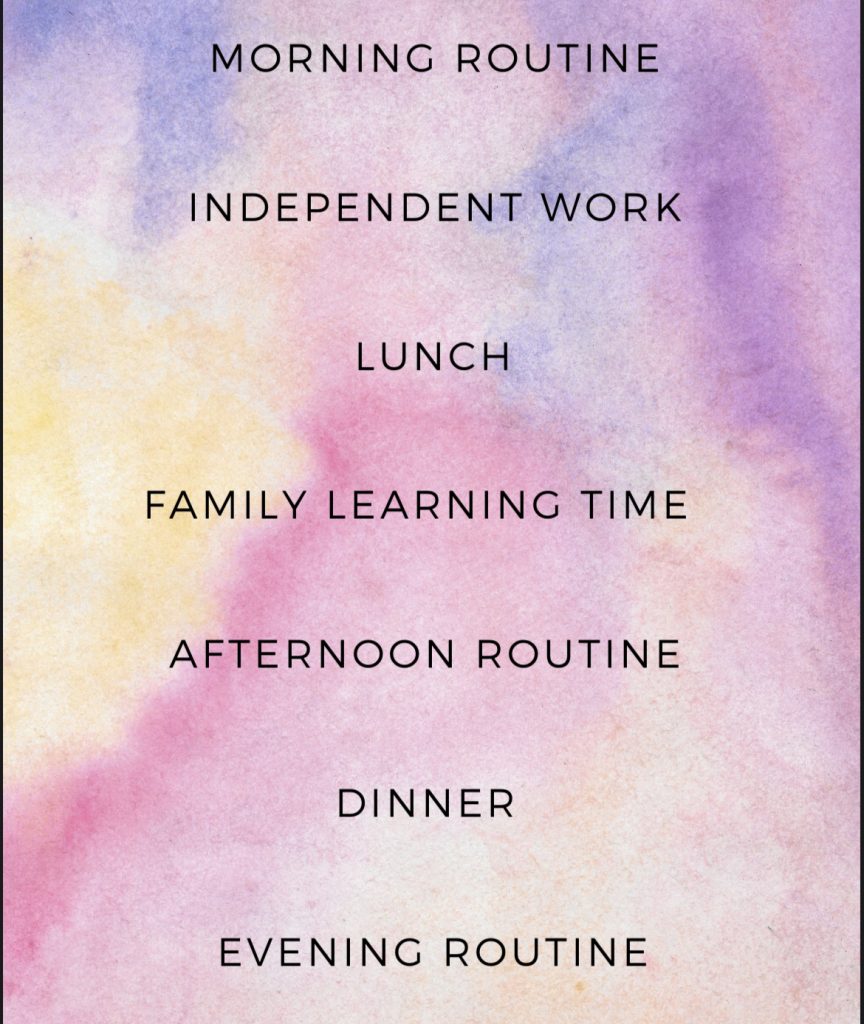Home Education Routines and Schedules! love them or hate them everyone is talking about them! Why would you want a routine when you home educate? Surely people choose this lifestyle to have freedom from routine?
This post is the first in a series of posts on how to create Home Education Routines and Schedules that work. In this post I will provides tips on creating a basic daily framework using a technique called time blocking. Once you have the basic daily framework in place you can customise it for your own family.

It’s true that stepping away from the traditional schooling system does give a family more freedom and some families love having the autonomy of waking up each day and deciding what to learn on the fly. Alternatively, there are families who, while enjoying the freedom from a government imposed curriculum, still want, and in fact do better, with the structure of a routine and schedule in place.
Why are Routines and Schedules Beneficial?
For Children
Establishing a routine and schedule for some children is key in fostering their overall development and well-being. Consistent routines provide a sense of stability and predictability, offering children a framework within which they can thrive.
A thoughtful and well-structured schedule not only helps in organising daily activities but also instills a sense of discipline and responsibility in young minds. Predictable routines contribute to a child’s emotional security, as they know what to expect, reducing anxiety and stress.
Moreover, routines play a pivotal role in promoting healthy habits, such as regular sleep patterns, balanced nutrition, and designated times for learning and play. Furthermore, routines and schedules, when established via age appropriate discussions with your children, can empower them with a sense of control over their daily life.
For Adults
Routine and schedule are equally crucial for some adults as they provide a framework for managing daily responsibilities and achieving long-term goals. In the midst of busy and demanding lives, a well-established routine helps adults navigate through various tasks efficiently, reducing stress and promoting a sense of control.
A structured schedule aids in time management, allowing individuals to allocate sufficient time for external work, household tasks, home education, personal activities, and relaxation. Consistent routines also contribute to the development of positive habits, such as regular exercise, healthy eating, and sufficient sleep, which are essential for maintaining physical and mental well-being.
Furthermore, a set schedule can enhance productivity, as it helps adults prioritise tasks and stay focused on their objectives.
My Experience with Routines and Schedules
Personally, I am a routine person, and as you read above the benefits of having a routine are numerous, but its also that the framework of a routine can be my saving grace to fall back on. The additional benefits can be as simple as less decision fatigue, as each step is already set out, to helping me get started again when interruptions inevitably happen, to helping create more independent children as they can move from one step to the next without me always being present.
A Basic Daily Framework
If the thought of a routine causes you to feel stifled or trapped then you shouldn’t feel the need to implement one but if you want a routine and schedule but don’t know where to start then some of these tips may help you create a basic daily framework from which you can add to.

The first thing I do is search for lots of other peoples routines on Instagram, i.e. check out the hashtags on routine posts. The routines I like the look of all get saved to a folder on my Instagram (almost like a Pinterest board). I then look for the simplest form of routine to outline a typical day. Obviously there are field trip days and days when the routine won’t work but I am not looking for perfection just a guide initially.
From my research I came up with the basic routine pictured above. Remember to make it work for your family and don’t try to put something into place that simply won’t suit your family. For example if you all like a lay in don’t plan on an early morning lesson set.

This may seem really simple but you need this basic outline first, think of your day in large blocks of time. Then you can work on the details. You can add times to the blocks. For some a basic outline is enough but I want to get down to the exact information of who, what and when. See my next post where I will expand on this routine outline.

A routine is very helpful, as far as I am concerned. Even though I am now retired, I like to structure my day to some extent (not all of it, sometimes I take a nap!) because that allows me to do more of what I want instead of annoyed that I didn’t get done what I wanted.